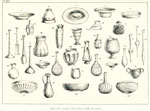Previous First Next
SALAMIS IN THE ISLAND OF CYPRUS.
BY ALEXANDER PALMA DI CESNOLÀ, F.S.A.,
page 90

of weight. No traces of iridescence appear on their surfaces, and yet their antiquity cannot be questioned;. for I found some of them in situations where they were not in contact with earth, that is, standing on stones, or in amphorǽ, and thus entirely protected from the effects of the air. Some of these relics, on being touched, fell to small pieces, that is, they thus returned to their first elements. Other articles have been in contact with the earth over parts only of their surfaces. Wherever this has been the case, iridescence occurs on those portions which have been subject to the influence of the earth. Many more relics are entirely iridescent, and exhibit flashings of the most lovely colours. These have been in closecontact with earth, and experienced its effects. It is to be added that the character of the decomposition in question varies according to the nature of the earth which surrounded the relics. Diggers who were accustomed to seek them were ableto decide in what kind of earth any given relic had been discovered. Some of these examples have been subject to diverse influences, e.g., the inside of a vase has contained a liquid, or other substance, which produced one kind of iridescence, and the surface of that part of the example is granulous, while the outside of the same has been affected by other

Previous First Next
|